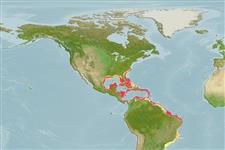分類 / Names
共通名の | 類義語 | Catalog of Fishes(部類, 種) | ITIS | CoL | WoRMS | Cloffa
Environment: milieu / climate zone / depth range / distribution range
生態学
海 関連する礁; 移住性ではない; 深さの範囲 1 - 150 m (Ref. 26938), usually 1 - 40 m (Ref. 89707). Subtropical; 36°N - 28°S, 98°W - 33°W (Ref. 5222)
Western Atlantic: South Carolina, USA and Bermuda to southern Brazil.
Length at first maturity / サイズ / 重さ / 年齢
Maturity: Lm 14.7 range ? - 24.5 cm
Max length : 44.0 cm TL オス/雌雄の選別がない; (Ref. 116036); 最大記録サイズ: 11 年 (Ref. 36271)
背面の脊椎 (合計) : 9; 背鰭 (合計) : 14 - 16; 肛門の骨: 3; 臀鰭: 9. Body and fins red; many small blue spots edged with black line scattered on body; dorsal edge of caudal peduncle with 2 prominent black spots; a pair of black blotches on tip of lower jaw (Ref. 13608); depth of body 2.6-2.9 in SL; head length 2.3-2.5 in SL; flat interorbital area; rounded preopercle, with shallow notch above the angle with upper edge finely serrate and moderately enlarged, lower edge fleshy; subopercle and interopercle smooth; posterior and anterior nostrils small and subequal; scaly maxilla, reaching to or beyond vertical at rear edge of eye; caudal fin convex posteriorly, corners angular; ctenoid lateral-body scales (Ref. 089707).
Adults prefer coral reefs and clear water. In the Gulf of Mexico, they are found in clear deep reefs (at least 45 m). At Bermuda and the West Indies, they are common in shallow water, but they usually hide in caves or under ledges during the day. The species is protogynous with females maturing at 16 cm TL and transforming to males at about 20 cm. Males are territorial. Feed mainly on small fishes and crustaceans. May follow morays and snake eels to feed on flushed preys. Wary, but approachable (Ref. 9710).
Mature females transform to males at a length of about 20 cm. Spawning occurs just before sunset over several days, and a male will spawn daily with each of the several females in his harem. Fecundity estimates range from about 150,000 to 282,000 eggs per female; with eggs 0.95 mm in diameter and having a single oil globule.
Heemstra, P.C. and J.E. Randall, 1993. FAO Species Catalogue. Vol. 16. Groupers of the world (family Serranidae, subfamily Epinephelinae). An annotated and illustrated catalogue of the grouper, rockcod, hind, coral grouper and lyretail species known to date. Rome: FAO. FAO Fish. Synop. 125(16):382 p. (Ref. 5222)
人間に対する脅威
Reports of ciguatera poisoning (Ref. 30303)
Human uses
水産業: 商業; 水族館・水槽: 商業
用具
特記事項
XMLをダウンロードして下さい
インターネットの情報源
Estimates based on models
Preferred temperature (Ref.
123201): 24.4 - 28, mean 27 °C (based on 474 cells).
Phylogenetic diversity index (Ref.
82804): PD
50 = 0.5000 [Uniqueness, from 0.5 = low to 2.0 = high].
Bayesian length-weight: a=0.01175 (0.00951 - 0.01452), b=3.04 (3.01 - 3.07), in cm total length, based on LWR estimates for this species (Ref.
93245).
栄養段階 (Ref.
69278): 4.1 ±0.4 se; based on diet studies.
回復力 (Ref.
120179): 手段, 1.4年~4.4年の倍増期間の最小個体群 (tmax=11; K=0.14-0.63; Fec=67,000-280,000).
Prior r = 0.62, 95% CL = 0.41 - 0.93, Based on 2 data-limited stock assessments.
Fishing Vulnerability (Ref.
59153): High vulnerability (58 of 100).
Climate Vulnerability (Ref.
125649): High vulnerability (58 of 100).
Nutrients (Ref.
124155): Calcium = 24.9 [10.8, 55.0] mg/100g; Iron = 0.454 [0.230, 0.923] mg/100g; Protein = 19.2 [17.4, 20.9] %; Omega3 = 0.268 [0.145, 0.478] g/100g; Selenium = 20.8 [9.1, 42.0] μg/100g; VitaminA = 65.7 [20.5, 244.1] μg/100g; Zinc = 0.555 [0.365, 0.939] mg/100g (wet weight);
